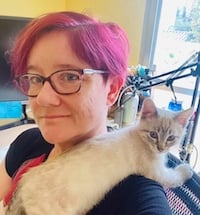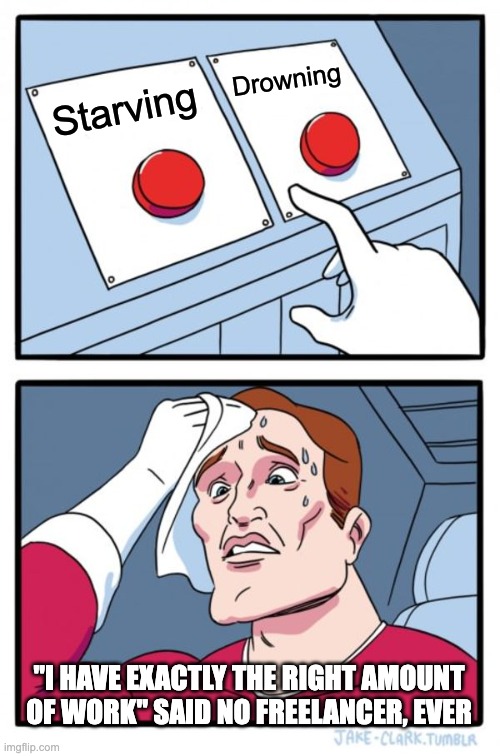A successful freelancer’s guide to finding long-term clients

on July 24, 2023 • 8 minute read

Many of us turn to freelancing because we love the variety it offers, and we’re good at the hustle and pitching too. But in the world of solopreneurship, collaborating with long-term clients is an essential skill to master. Clients who provide a steady stream of work, reliable income, and the opportunity to build meaningful, mutually beneficial relationships.
So, how do you find these mythical beasts and, more importantly, how do you convince them to stick around? Is it easier to just go after the next gig with someone new?
Whether you're a seasoned freelancer or just starting your journey, I want to help you think about your freelancing as a sustainable, successful business, in which longer-term relationships are fundamental.
The importance of long-term clients for freelancers
In the rollercoaster world of freelancing, stability might sound like a luxury. However, it's a luxury that long-term clients can provide. These are clients who offer ongoing work, often over several months, or even years.
They are the bedrock of a successful freelance business, and here's why:
Long-term clients create steady freelance income
You must have seen that meme that reads something like: “I have exactly the right amount of work right now,” said no freelancer ever.

If you’ve been freelancing for more than 5 minutes, I know you will relate — the greatest challenge most freelancers face is that feast-or-famine cycle. Some months you're swamped with work and daren’t turn it away, while other times are worryingly quiet. It goes with the territory for sure, but long-term clients can help smooth out these income fluctuations, providing a reliable revenue stream that allows you to plan your finances with confidence.
Of course nothing is forever, and those relationships can end at any time. But so can employment these days. While you can write complex retainer contracts with clients, I personally believe that cementing the interpersonal relationship is more important for lasting work.
Find your perfect long-term client relationship with Xolo.
Long-term clients mean less time marketing your freelance services
Before you can cook and eat, you have to hunt!
Finding new clients is time-consuming. It involves marketing your services, sending proposals, and doing all the inbound and social stuff around creating a unique presence. You might love doing this, from the personal brand creation to the thrill of the chase in a live pitch, but remember: you do not get paid for that time.
Even when the work comes to you as a result of your reputation and skill, you still spend non-billable hours on discovery and establishing relationships and fit, and doing completely new work likely takes you a little longer anyway.
When you have long-term clients, you spend a greater portion of your time on paid work. You get down to cooking something valuable more quickly, and apply your fine creative skills to create something delicious your existing clients will love.
Having long-term freelance clients means stronger relationships
Working with a client over the long term allows you to build a strong, collaborative relationship. You get to know their business intimately, understand their needs and preferences, and become a valued partner rather than just a service provider.
This not only makes the work more enjoyable, but also leads to better results. You develop an instinct for what they need, and you care about the outcomes. You share in their successes and feel proud of what you’re creating together.
Long-term freelance clients increase your professional credibility and help you grow
Having long-term clients in your portfolio demonstrates that you deliver consistent quality and are reliable. This can enhance your reputation and make it easier to attract new clients, showing that you are a valued partner who thinks beyond the next gig to the client’s own interests and goals.
Long-term clients often provide opportunities for growth. As their business evolves, they might need additional services or higher-level strategic input. If you've proven your value, you're well-positioned to meet these needs.
In contrast, short-term or one-time projects, while they can be exciting and varied, don't offer the same benefits. They might be perfect for filling gaps or exploring new industries, but they don't provide the stability and growth potential that long-term clients do.
Panning for gold: How to identify potential long-term freelance clients
How do you know if your next prospect wants a lasting relationship, and isn’t going to ghost you after a one-night stand?
Knowing how to identify potential long-term clients is an essential skill for freelancers. It’s part of developing your ideal client avatar. Not everyone is a suitable candidate for a long-term relationship, and understanding the signs can save you time and effort. Or at least it can help you evaluate whether to invest in the relationship, beyond the immediate offered gig.
Look for businesses with ongoing needs
Some businesses or industries have a continuous need for certain freelance services. For example, content-heavy industries like digital marketing, publishing, or software development often require long-term writers, designers or developers. Similarly, businesses undergoing rapid growth or change may require ongoing support from freelancers in areas like project management or business consulting.
Consider the role of your present gig. You’re not just auditioning for the next one, but you may be making it more likely to happen… If you help create a pitch deck or white paper which helps your client secure funding, or a website which generates sales, they’ll likely be back for more.
During your initial project discussions, listen for hints about their future plans. If they talk about next projects or mention ongoing needs, these could be opportunities for long-term work. If you ask about these longer-term plans, it not only demonstrates you care about their goals, it can even encourage them into visualizing you delivering that work specifically (a handy tip we can borrow from job interviewing, even if we are proudly unemployable solopreneurs ourselves!).
Assess their previous freelancer relationships
During initial conversations, ask potential clients about their experience with freelancers. Have they worked with freelancers on a long-term basis before?
If they have a history of long-term freelancer relationships, it's a good sign they're open to one with you. But if they mention freelancers as one-off contractors rather than lasting collaborators and consultants, then that’s likely the relationship they have in mind with you as well — approach your costing and intent with that in mind.
Consider their business size and stability
Larger, more established businesses are increasingly likely to have the budget and volume of work necessary for a long-term freelance relationship.
However, don't discount SMEs. Your sweet spot might be the smaller teams where there are regular gaps to plug with outside talent, and they may have more flexible terms.
If they're growing and have solid funding, startups can also become excellent long-term clients. Actually, I love working with startups! If I can help them get their comms right and get funded, it’s a great basis for a long-term relationship. It means varied and interesting work with a single client, and sharing in the vicarious thrill of their growth (without me being all-in like a founder or partner).
Evaluate their communication, professionalism, and mission
Good communication is crucial for a successful long-term relationship. If a potential client communicates clearly, respects your time and behaves professionally from the start, these are positive signs for a potential long-term engagement.
And if you’re going to work with someone and support their business objectives, it really helps if you share those goals and care about them.
Remember, identifying potential long-term clients is just the first step.
Once you've identified them, you'll need to impress them with your skills and professionalism, and then nurture the relationship over time.
Where and how to find long-term freelance clients
Finding any client as a freelancer involves a mix of proactive searching and positioning yourself to be found. Here are some strategies to consider:
Social media and inbound marketing
Platforms like LinkedIn, Twitter (and its recent clones) and even Instagram, can be effective for finding long-term clients. They allow you to showcase your work, connect with potential clients, and stay top-of-mind, joining in relevant conversations with influential people in your industry.
Building a strong online presence takes time and consistent effort, but is a great way to position yourself as the expert in your niche.
Networking events
Industry conferences, meetups and other networking events can be a goldmine for long-term clients. They offer the opportunity to make personal connections and leave a lasting impression.
The downside is that they can be time-consuming and expensive, so look locally first — check out Meetup and Eventbrite to see what’s on your doorstep, before you budget for big international conferences.
Remember these costs are legitimate business expenses, and Xolo makes it easy to account for all of these costs ahead of your taxed income.
Referrals and recommendations
Word-of-mouth referrals from satisfied clients can lead to long-term work. Encourage your clients to refer you to others, and to repeat private praise publicly: “Thank you so much for that lovely feedback — if I send you a request, would you consider copy-pasting that as a LinkedIn testimonial? It would mean the world to me.”
Your current clients don’t know about the rest of your workload, or lack of it, so be direct and ask them for help.
Freelance job boards
Platforms like Upwork, Freelancer, and Fiverr can be a good starting point. They offer a wide range of gig postings, including long-term projects. However, competition can be high, and it may take time to build a strong profile and reputation. Furthermore, the vast majority of advertised offers tend to be gig-by-gig, one-off projects.
That’s why you should definitely check out Xolo. It's a community of specialist freelancers and solopreneurs where you can learn from others, share your experiences, and gain access to valuable tools and resources. It’s wise to begin building your brand and reputation in a thriving new platform that cultivates long-term relationships with clients.
Remember, finding long-term clients is often a numbers game. The more potential clients you connect with, the higher your chances of finding those gems.
How to build long-term relationships with clients as a freelancer
Securing a long-term client is simply the beginning. The real work lies in nurturing that relationship and consistently delivering excellence.
A strong relationship with a client goes beyond just being friendly. It's about trust, reliability and understanding. Clients who trust you and rely on your expertise are more likely to keep coming back. They're also more likely to refer you to others, or simply talk positively about you.
Here are some tactics to help you build and maintain strong relationships with your clients:
- Communicate regularly and clearly: Keep your clients updated on your progress, ask for feedback, and be responsive to their queries. Regular communication shows that you're reliable and committed to their project. It also helps you catch and address issues early, before they become bigger problems.
- Deliver high-quality work: This might seem obvious, but it's worth emphasizing. Consistently delivering high-quality work is the best way to impress your clients and secure long-term work. It shows that you take your work seriously and that you can be relied upon. If you make them look good to their manager, they’ll definitely be back.
- Understand their needs and goals: Take the time to understand your client's business, their industry and their goals. Brief yourself on their products/services, ask questions. This will allow you to tailor your services to their needs and provide more value. It also shows that you're invested in their success, which can strengthen your relationship.
- Be proactive: Don't wait for your clients to come to you with problems or ideas. Be upfront in suggesting improvements, identifying potential issues, and proposing new projects. This indicates that you're thinking about their business and are committed to helping them succeed.
- Handle Challenges Gracefully: No long-term relationship is without its challenges. There might be disagreements, scope changes, budget shifts, or other issues to navigate. How you handle these challenges can make or break your relationship. Be professional, listen to your client's concerns, and work together to find a solution.
Above all:
Be a joy to work with! Sure, you’re brilliant at what you do. But realistically, in a global marketplace, so are other people. You need to be the one they go to because they love collaborating with you personally. That’s why you’re their go-to freelancer, that they turn to first, every time.
Building strong relationships with your clients is not just about securing long-term work. It's also about enjoying your work more and feeling like a valued part of your client's team. So invest time and effort into nurturing these relationships.
Key steps to find and retain long-term clients as a freelancer: Conclusion
- Understand why you need long-term clients for freelancing stability and profitability
- Identify potential long-term clients: define the attributes which separate the casual relationships from the lasting partners
- Connect with your perfect clients: Use social media, networking events, and referrals, to showcase your work and your partnership potential
- Build and maintain strong client relationships: Be the best freelancer they ever worked with
- Treat every client as a potential long-term relationship, because you never know if they will be your next one
It’s all about relationship:
The journey to finding and retaining long-term clients as a freelancer may be challenging, but it's undoubtedly rewarding. It provides stability, growth opportunities, and the chance to build meaningful relationships. The secret lies in understanding the importance of these clients, identifying potential long-term opportunities, and nurturing these relationships with consistent excellence and proactive communication.
Remember, every long-term client was once a first-time client. So, treat every new client as a potential long-term relationship, and invest in those relationships as if your freelance business depends on it — because it does.
Find your long-term clients as a freelancer with Xolo.
About Maya
Maya Middlemiss is a freelance journalist and author, excited about the future of work, business, money, and technology. She operates her e-resident business through Xolo Leap, so that she can work frictionlessly with brands and publications all over the world, and she is the host of the Future is Freelance podcast. Exploring the social impact of technology on our changing world, and bringing those stories to life in an accessible and inclusive way, is her passion — because all of this is far too exciting to leave it to the geeks. Maya is a 'digital slowmad', originally from London, presently living with her family in Eastern Spain.
Table of contents
Discover quality, long-lasting clients and connect with talented freelancers using Xolo
Start connectingRelated blogs
Subscribe to
our newsletter
and get the latest updates and expert
business tips straight to your inbox.
